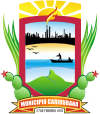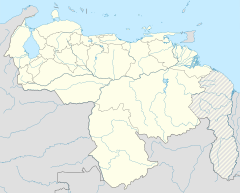Punto Fijo facts for kids
Quick facts for kids
Punto Fijo
|
|||
|---|---|---|---|
|
Municipality
|
|||

Punto Fijo Church
|
|||
|
|||
| Nickname(s):
"La Ciudad del Viento"
|
|||
| Country | |||
| State | Falcón | ||
| Government | |||
| • Type | Mayor–council | ||
| • Body | Alcaldía de Carirubana | ||
| Elevation | 6 m (20 ft) | ||
| Population
(2022)
|
|||
| • Total | 131,784 | ||
| Demonym(s) | Puntofijense | ||
| Time zone | UTC-04:00 (VST) | ||
| • Summer (DST) | UTC-04:00 (not observed) | ||
| Postal coded |
4102
|
||
| Area code | 269 | ||
| ISO 3166 code | VE-A | ||
| Climate | BWh | ||
| The area and population figures are for the municipality. | |||
Punto Fijo is an important city in northern Falcón State, Venezuela. It is the capital of the Carirubana municipality. The city is located on the southwest coast of the Paraguaná Peninsula.
Punto Fijo is the largest city in Falcón State. Its metropolitan area includes the areas of Norte, Carirubana, Punta Cardón, and Judibana. Judibana is in the Los Taques municipality.
Contents
History of Punto Fijo
Punto Fijo was started in the early 1940s. It grew near two oil refineries. These refineries were built by companies called Standard Oil and Shell in the 1940s.
The city's name, Punto Fijo, means "fixed point." A local historian, Rafael González Estaba, said it was a common stopping place for travelers and fishermen. They would always stop at this "fixed point."
The city had about 270,000 people in 2002. Most of these people live in the city center.
Economy and Industry
Punto Fijo is very important for Venezuela's economy. It has the world's second largest oil refinery complex. This complex is called the Paraguaná Refinery Complex (CRP). It includes the Amuay and Cardón Refineries.
These refineries used to process about 1 million barrels of oil every day. This oil helped power the local and regional economy.
Other Industries
Punto Fijo also has a large fishing fleet. It is the second most important fishing fleet in Venezuela. The city also has an industrial area. Here, you can find factories that make electronics and light machinery.
Free Zone for Business
Punto Fijo has a special "Free Zone for Touristic Investment." This means that businesses can bring in goods without paying extra taxes. This helps attract more businesses and tourists.
New Developments
The city is growing and developing quickly. Because of this, local and national leaders are building new public projects. These projects include a main bus station and repairs to roads. A new power plant, "Josefa Camejo," has also been built.
Private companies are also investing in the city. They have built large shopping malls like Sambil Mall Paraguaná and Paraguaná Mall. These new malls join the older Centro Comercial y Recreacional Las Virtudes Mall.
Getting Around Punto Fijo
Punto Fijo has many roads that cross the city. A new bus terminal was built to help people travel.
Road and Air Travel
The city is connected to Coro by a modern highway. This highway has two lanes and offers beautiful views. You can see the Médanos de Coro National Park and the plants of this dry region.
For air travel, people use Las Piedras Airport. It is also known as Josefa Camejo International Airport.
Geography of Punto Fijo
Punto Fijo is located on the southwest coast of the Paraguaná Peninsula. It is the biggest city in Falcón State. The city's main area includes the parishes of Norte, Carirubana, Punta Cardón, and Judibana.
Punto Fijo Climate
Punto Fijo has a hot and dry climate. It is known as a "hot arid climate" or BWh according to the Köppen climate classification. This means the weather is hot all year long.
The city gets very little rain. Most of the rain falls from August to December. Punto Fijo is one of the driest places in South America. It gets only about 180 millimeters (7 inches) of rain each year. This is much less rain than other nearby cities.
| Climate data for Punto Fijo | |||||||||||||
|---|---|---|---|---|---|---|---|---|---|---|---|---|---|
| Month | Jan | Feb | Mar | Apr | May | Jun | Jul | Aug | Sep | Oct | Nov | Dec | Year |
| Mean daily maximum °C (°F) | 29.8 (85.6) |
30.0 (86.0) |
30.6 (87.1) |
31.3 (88.3) |
31.8 (89.2) |
32.3 (90.1) |
32.4 (90.3) |
33.1 (91.6) |
32.7 (90.9) |
31.5 (88.7) |
30.5 (86.9) |
30.0 (86.0) |
31.3 (88.4) |
| Daily mean °C (°F) | 26.2 (79.2) |
26.3 (79.3) |
26.8 (80.2) |
27.4 (81.3) |
28.0 (82.4) |
28.3 (82.9) |
28.3 (82.9) |
28.9 (84.0) |
28.9 (84.0) |
28.2 (82.8) |
27.5 (81.5) |
26.8 (80.2) |
27.6 (81.7) |
| Mean daily minimum °C (°F) | 24.1 (75.4) |
24.0 (75.2) |
24.4 (75.9) |
25.2 (77.4) |
25.8 (78.4) |
26.0 (78.8) |
25.8 (78.4) |
26.4 (79.5) |
26.5 (79.7) |
26.1 (79.0) |
25.5 (77.9) |
24.8 (76.6) |
25.4 (77.7) |
| Average rainfall mm (inches) | 8 (0.3) |
5 (0.2) |
6 (0.2) |
13 (0.5) |
30 (1.2) |
10 (0.4) |
7 (0.3) |
15 (0.6) |
52 (2.0) |
82 (3.2) |
67 (2.6) |
25 (1.0) |
320 (12.5) |
| Average precipitation days | 1 | 1 | 1 | 2 | 3 | 1 | 1 | 2 | 6 | 11 | 8 | 4 | 41 |
| Average relative humidity (%) | 75 | 73 | 72 | 74 | 75 | 74 | 73 | 72 | 75 | 78 | 79 | 77 | 75 |
| Source: Climatedata.org | |||||||||||||
See also
 In Spanish: Punto Fijo para niños
In Spanish: Punto Fijo para niños




